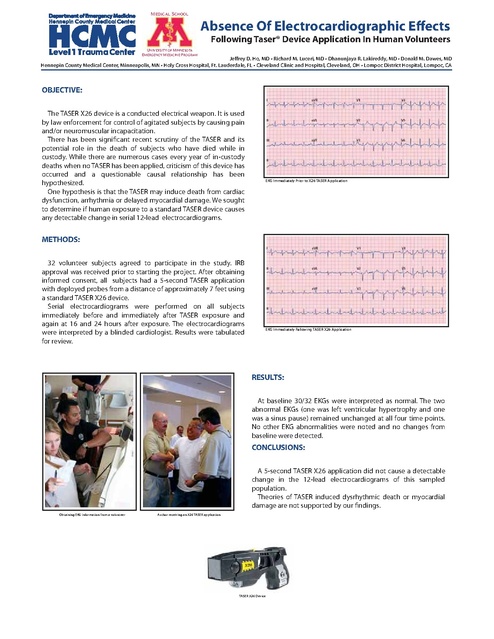Taser X26 Absence of Electrocardiographic Effects Minnesota
Download original document:

Document text

Document text
This text is machine-read, and may contain errors. Check the original document to verify accuracy.
MEDICAL SCHOOL Absence Of Electrocardiographic Effects Following Taser® Device Application In Human Volunteers UNIVERSITY OF MINNESOTA EMERGENCY MEDICINE PROGRAM Jeffrey D. Ho, MD • Richard M. Luceri, MD • Dhanunjaya R. Lakireddy, MD • Donald M. Dawes, MD Hennepin County Medical Center, Minneapolis, MN • Holy Cross Hospital, Ft. Lauderdale, FL • Cleveland Clinic and Hospital, Cleveland, OH • Lompoc District Hospital, Lompoc, CA OBJECTIVE: The TASER X26 device is a conducted electrical weapon. It is used by law enforcement for control of agitated subjects by causing pain and/or neuromuscular incapacitation. There has been significant recent scrutiny of the TASER and its potential role in the death of subjects who have died while in custody. While there are numerous cases every year of in-custody deaths when no TASER has been applied, criticism of this device has occurred and a questionable causal relationship has been hypothesized. One hypothesis is that the TASER may induce death from cardiac dysfunction, arrhythmia or delayed myocardial damage. We sought to determine if human exposure to a standard TASER device causes any detectable change in serial 12-lead electrocardiograms. EKG Immediately Prior to X26 TASER Application METHODS: 32 volunteer subjects agreed to participate in the study. IRB approval was received prior to starting the project. After obtaining informed consent, all subjects had a 5-second TASER application with deployed probes from a distance of approximately 7 feet using a standard TASER X26 device. Serial electrocardiograms were performed on all subjects immediately before and immediately after TASER exposure and again at 16 and 24 hours after exposure. The electrocardiograms were interpreted by a blinded cardiologist. Results were tabulated for review. EKG Immediately Fallowing TASER X26 Application RESULTS: At baseline 30/32 EKGs were interpreted as normal. The two abnormal EKGs (one was left ventricular hypertrophy and one was a sinus pause) remained unchanged at all four time points. No other EKG abnormalities were noted and no changes from baseline were detected. CONCLUSIONS: A 5-second TASER X26 application did not cause a detectable change in the 12-lead electrocardiograms of this sampled population. Theories of TASER induced dysrhythmic death or myocardial damage are not supported by our findings. Obtaining EKG information from a volunteer Author receiving an X26 TASER application TASER X26 Device





